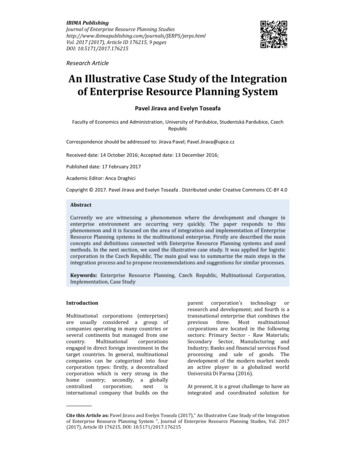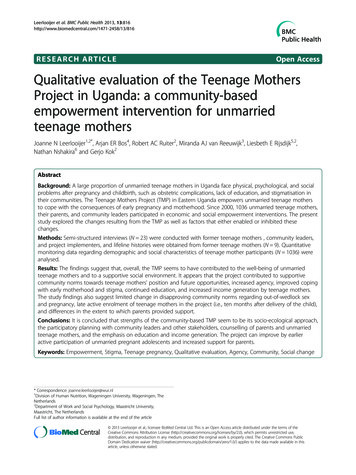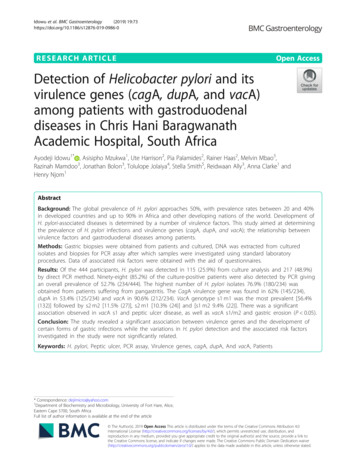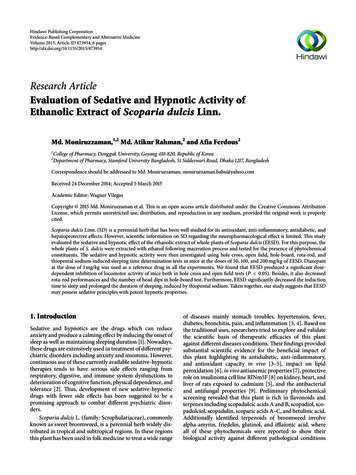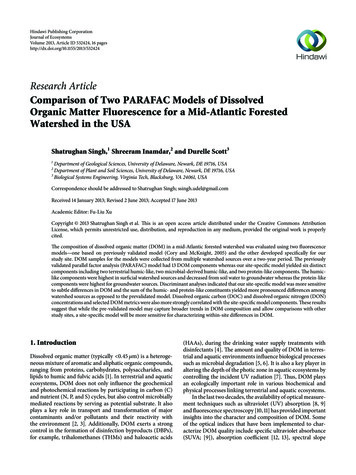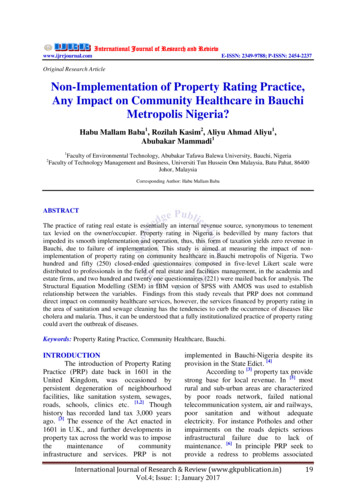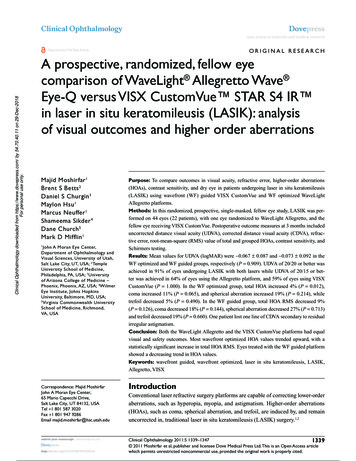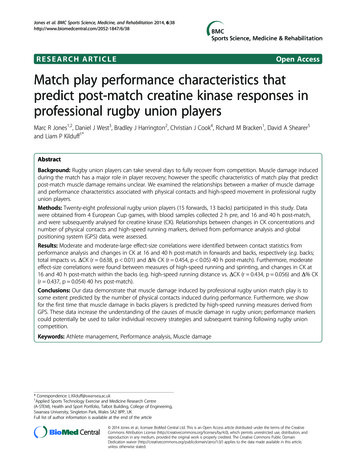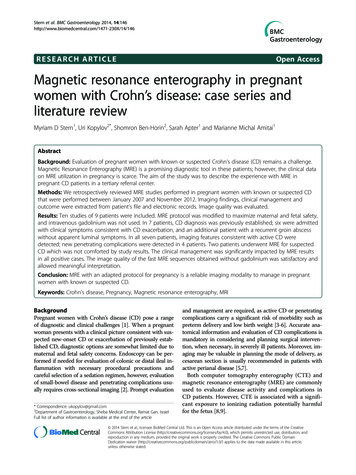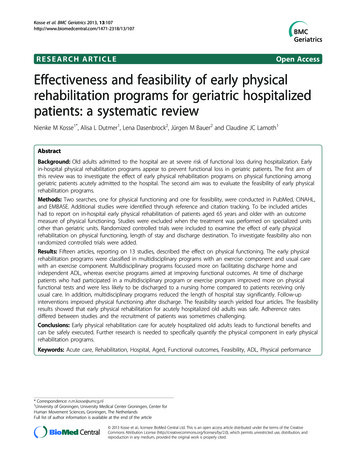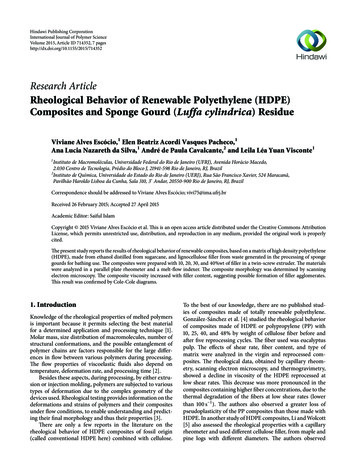
Transcription
Int. J. Pharm. Sci. Rev. Res., 44(1), May - June 2017; Article No. 37, Pages: 159-164ISSN 0976 – 044XResearch ArticleEvaluation of the Virucidal Effect by Contact with Water-insoluble Substances:The Case of XibornolMarco Verani1*, Ileana Federigi1, Cristina Bigini2, Fabrizio Nannipieri2, Stefano Ceccanti2, Sandra Vecchiani2, Annalaura Carducci11Hygiene and Environmental Virology Laboratory, Department of Biology, University of Pisa, Pisa, Italy.2Abiogen Pharma S.p.A., Pisa, Italy.*Corresponding author’s E-mail: marco.verani@unipi.itReceived: 23-02-2017; Revised: 15-04-2017; Accepted: 12-05-2017.ABSTRACTThe virucidal activity of xibornol has been known since the 70s, but its determination is primarily based on few clinical data.Experimental quantitative estimation in vitro is limited by the absence of appropriate test neither the European nor the AmericanPharmacopoeia; however some recent standards, concerning antiseptics, could be utilized for this purpose. The tests were carriedout by following the European Standard EN 14476, which foresees contact test between viruses and 3 different concentrations ofxibornol, in two experimental conditions and viral titer estimation by cell culture method. The tested viruses were chosen amongthose ones most closely responsible of upper respiratory tract infections: Human Adenovirus, Human Rhinovirus and Human Coronavirus. For the commercial concentration (3%), the results show a common trend for all the viruses with an estimated titer thatreached values below 1 log DCP50/ml after each condition contact test. The reduction was greater in clean conditions with averagevalue of 3 logs, compared to the test in dirty conditions (2 log). The data confirm the virucidal action of xibornol and show, for thefirst time, a quantitative variation in disinfection efficiency depending on contamination scenario.Keywords: Xibornol, virucidal activity, virus, cell culture tests.INTRODUCTIONThe virucidal activity of 6-isobornyl-3-4-xylenol (i.e.xibornol) has been known since the 1970s, and hasbeen repeatedly documented for about a decade,however its determination is primarily based on clinicaldata and partly on data obtained from qualitative studiesin vitro according to the state-of-the-art of the era (assayson embryonated eggs).For this reason, it was consideredappropriate to reassess a suspension formulated for oralhygiene by means of in vitro tests that investigate moreviruses, which are representative of the main pathogensresponsible for infections of the mouth and upperairways, and to quantify the virucidal activity of xibornol.Currently, unfortunately, neither the European nor theAmerican Pharmacopeia provides appropriate tests fordetermining the virucidal activity of drugs, so weconsidered international standards issued for determiningthe virucidal activity of antiseptics1.Although in the pastthe virucidal activity for these devices was determinedaccording to national standards or alternative methods tothese, such as “Viraden”, the activity has long beenevaluated by reference to the standards published by theEuropean Committee for Standardization2-3.We havedecided to adopt these standards as a reference and inparticular, the case that specifies test methods andminimum requirements for the evaluation by means oftests in suspension: EN 14476-20074. In fact, thisregulation is relatively recent; it has already beenimplemented by various national standard bodies,including the Italian one, and is applicable to nonfilterable samples, such as xibornol. The in vitro methodindicated consists of a challenge with the biocidal productunder controlled conditions (duration and exposureconditions) and in determining the consequent reductionof the viral titer. The method also includes tests to ensurethat the results are not affected by interferences such ascytotoxicity on cell cultures used for the titration.Compared to the standard, the following changes havebeen made: elimination of alcohol from the formulabecause it has virucidal activity and the use of aneutralizer for diluting the product, to eliminate thecytotoxic effects5-6. The virucidal activity of xibornol wasthen determined by extrapolation of the results obtainedat different dilutions and in the absence of synergy withalcohol.MATERIALS AND METHODSThe in vitro investigations were carried out using teststhat followed, as far as possible, the European standardUNI EN 14476 entitled “Virucidal activity of chemicaldisinfectants or antiseptic products for instruments,surfaces or hands, which form a physically stablehomogeneous preparation when diluted with hard wateror with water”, which involves the use of in vitro testsbased on cell cultures. The viruses on which to test theactive ingredient were selected from those most closelyresponsible for infections of the upper respiratory tract:Human Adenovirus, Human Rhinovirus and HumanCoronavirus7. The tests were conducted with ATCC strainsfor each of these viral agents (VR-5 Human AdenovirusType 5 Strain Adenoid 75; VR-286, Human Rhinovirus 13Strain 353; VR-740 Human Coronavirus Strain 229E),isolated on two cell lines: HeLa (ATCC CCL-2), susceptibleto infection by Human Adenoviruses and HumanRhinovirus and MRC-5 (ATCC CCL-171), susceptible toinfection by Human Coronavirus.International Journal of Pharmaceutical Sciences Review and ResearchAvailable online at www.globalresearchonline.net Copyright protected. Unauthorised republication, reproduction, distribution, dissemination and copying of this document in whole or in part is strictly prohibited.159
Int. J. Pharm. Sci. Rev. Res., 44(1), May - June 2017; Article No. 37, Pages: 159-164ISSN 0976 – 044XViral titrationLaboratory tests of virucidal activityThe viruses were titrated using the Karber method, whichallows detection of the cytopathogenic dose that affects50% of the inoculated cells (DCP50)8.The procedurefollowed is the standard one recommended by the UNIEN 14476 and involves the seeding of viruses inmicroplates with cytopathic effect evaluation after 5 days.The tests were performed according to the Europeanstandard UNI EN 14476, considering two conditions:“clean” and “dirty”. For each of the three viruses, threereplicates were performed, with mixtures of 10 mlconsisting of 1 ml of Labrasol (“clean” tests) or 1 ml offetal bovine serum (using for “dirty” tests); 8 ml ofdisinfectant for each dilution (8%, 3%, 0.5%) at non-toxicconcentrations for the cell cultures, corresponding to0.008 g/100 ml; 0.03 g/100 ml and 0.05 g/100ml,respectively, diluted in Labrasol, and 1 ml of virus ofknown titer. For the tests performed in “dirty” conditions,the erythrocytes were not mixed together with the fetalbovine serum, differently to that indicated by theEuropean standard, because of the interference effectthat they have on the cell lines used in the tests. Overall,for each agent, six disinfectant-virus combinations weretested (three for the clean tests and three for the dirtytests). Furthermore, for each replicate, a negative controlwas added, consisting of 1 ml of virus and 9 ml of Labrasol(“clean” tests) or 8ml Labrasol 1 ml fetal bovine serum(“dirty” tests). After a contact time of 15 minutes, themixtures were analyzed to evaluate the residual viral titerby titration method.Evaluation of the toxicity of xibornol against the cell lineThe tests to check the toxicity of the disinfectant on thecell lines were carried out according to the protocol of thestandard UNI EN 14476.As a premise to these, however, itshould be emphasized that xibornol is soluble in alcohol(ethanol), which is already well known to have toxiceffects on cell cultures. The disinfectant was tested atthree different dilutions: 8%, 3% (the commercialdilution) and 0.5%. For each test, 2 ml of suitablyprepared hard water was mixed with 8 ml of disinfectantfor each dilution. These mixtures were serially dilutedwith culture medium and serum, and the dilutions (1:10;1:100; 1:1000) were seeded in flasks with a layer ofconfluent cells. After 1 h of contact, the mixtures wererecovered, culture medium and 2% serum were addedand the flasks were incubated at 37 C. The flasks wereobserved under the microscope at different times (after 1h and then daily for 5 days or until the appearance ofapparent toxic effects on the cells). A maximum of 5 daysof observation was envisaged, to take into account theobservation times required for the viral titrations.Detoxification testsFor the cell lines, regarding the toxicity to xibornol and tothe ethanol in which it was diluted, it was decided to usedisinfectant preparations where the active ingredient wasdiluted in solutions other than water, with the aim ofbeing able to test the conditions involving both solutionsand suspensions. Even for these new mixtures, it wasnecessary to test the toxicity for the cell lines followingthe same method of the previous tests. The disinfectantwas tested in solution (xibornol Labrasol) and insuspension (xibornol Avicel RC 591), each at differentdilutions: 8%, 3% (the commercial dilution) and 0.5%. Foreach test, mixtures were assayed that were composed of2 ml of suitably prepared hard water and 8 ml ofdisinfectant for each dilution, both in suspension and insolution. These mixtures were serially diluted with culturemedium and serum, and dilutions (1:10; 1:100; 1:1000)were seeded in flasks with a layer of confluent cells. After1 h of contact, the mixtures were recovered, culturemedium and 2% serum were added and the flasks wereincubated at 37 C. The flasks were observed under themicroscope at different times (after 1 h and then daily for5 days or until the appearance of apparent toxic effectson the cells). A maximum of 5-7 days of observation wasenvisaged, to take into account the observation timesrequired for the viral titrations. Both Labrasol and AvicelRC 591 were inoculated in two separate flasks to indicateany effects on the cells independently from xibornol.Statistical AnalysisThe data obtained were analyzed with the programMicrosoft Excel for evaluating the means and totallogarithmic standard deviations, and for the graphicalrepresentation of the trend and of the viral abatement toxibornol concentrations.RESULTS AND DISCUSSIONViral titrationThe titers obtained were: 1.2 x 105 DCP50/ml for HumanAdenovirus 5, 7.5 x 105 DCP50/ml per Human Coronavirus4and 1.5 x 10 DCP50/ml for Human Rhinovirus.Evaluation of the toxicity of xibornol against the cell lineHeLaThe toxicity tests revealed a widespread xibornol toxiceffect for cells lines already after 1 contact day for all thedilutions. From these results, it was necessary to include adetoxification step of the virus-disinfectant mixturebefore seeding on cells. Furthermore, the insolubility inwater of xibornol prevented, even at higher dilutions, theexact use of the procedure relative to the Europeanstandard UNI EN 14476.In fact, dilution with hard wateras suggested by this standard, produced a large amountof precipitate. The toxicity of the ethanol (well known)used for the dilution of the disinfectant was added to thetoxicity of the xibornol itself.Detoxification testsThe results reported in Table 1 take into account the toxiceffects that are seen before 5 days.International Journal of Pharmaceutical Sciences Review and ResearchAvailable online at www.globalresearchonline.net Copyright protected. Unauthorised republication, reproduction, distribution, dissemination and copying of this document in whole or in part is strictly prohibited.160
Int. J. Pharm. Sci. Rev. Res., 44(1), May - June 2017; Article No. 37, Pages: 159-164ISSN 0976 – 044XTable 1: Detoxification trials resultsSolution (xibornol Labrasol) 8%Solution (xibornol Labrasol) 3%Solution (xibornol Labrasol)0.5%LabrasolSospension (xibornol Avicel RC591) 8%Sospension (xibornol Avicel RC591) 3%Sospension (xibornol Avicel RC591) 0.5%Avicel RC 591Dilutions of the mixtureToxic Effect within 5 daysStart of the Toxic EffectNo diluteYES1h1:10YES1h1:100YES1h1:1000YES1hNo diluteYES1 day1:10YES1h1:100YES1h1:1000NO7 daysNo diluteYES1 day1:10YES2 days1:100NO7 days1:1000NO7 daysNo dilutionNO7 daysNo diluteYES1h1:10YES1h1:100YES1h1:1000YES1hNo diluteYES1h1:10YES1h1:100YES1h1:1000YES1 dayNo diluteYES1h1:10YES1h1:100YES2 days1:1000NO6 daysNo dilutionYES1hFrom these results it was found that both the suspensionand the solution are more soluble comparing to themixtures of xibornol previously provided. However,different toxic effects can still be noted:Solution: The toxic effect for each dilution with culturemedium, which is predominantly an aqueous solution,seems to decrease in relation to the concentration of thedisinfectant. It should be noted that Labrasol in itself isnot toxic.Suspension also in this case, the toxic effect for eachdilution is reduced in proportion to the concentration ofthe disinfectant. However, it is noted that in this caseAvicel RC 591 in itself is toxic.From the obtained data, it was suggested to carry out thetests on the virucidal activity exclusively considering thesolutions through variation of the protocol UNI EN. Inparticular, replacing the hard water and the culturemedium, it was decided to directly use Labrasol as thediluent of the disinfectant, thus avoiding the toxic effectthat defines the mixing with these aqueous solutions and,therefore, being able to test less diluted preparations(Table 2).Laboratory tests of virucidal activityThe mean results are reported in the following tables andare sorted by virus and type of test (Tables 3-4-5). Thelogarithmic viral abatement, relating to the differentworking concentrations and conditions, for HumanAdenovirus 5, resulted in a range from 2.4 to 3.3 in cleanconditions and constant for dirty ones with a mean of 2log reduction. Human Coronavirus abatement resultedhigher in clean conditions (3.4-3.6) than in dirty ones (2.32.5); instead Human Rhinovirus reduction seemed to notbe influenced by conditions. These data confirmed theprotection role against disinfection for viru
suspension (xibornol Avicel RC 591), each at different dilutions: 8%, 3% (the commercial dilution) and 0.5%. For each test, mixtures were assayed that were composed of 2 ml of suitably prepared hard water and 8 ml of disinfectant for each dilution, both in suspension and in solution. These mixtures were serially diluted with culture medium and serum, and dilutions (1:10; 1:100; 1:1000) were .
